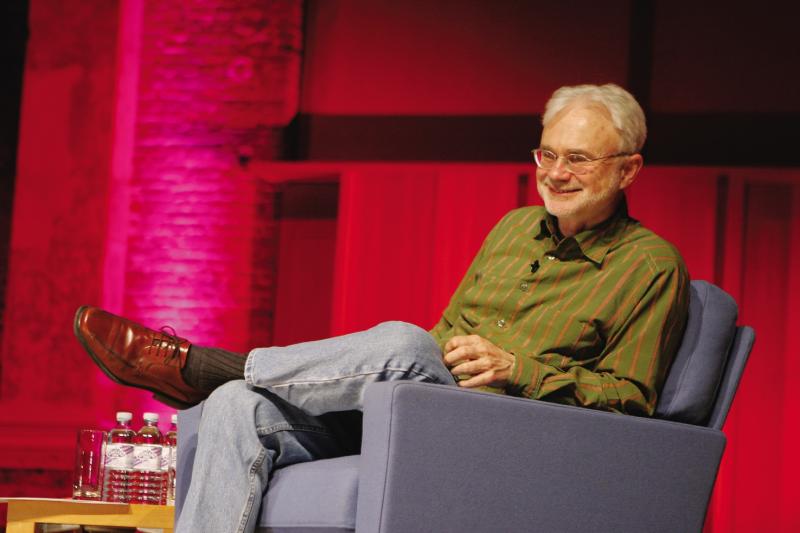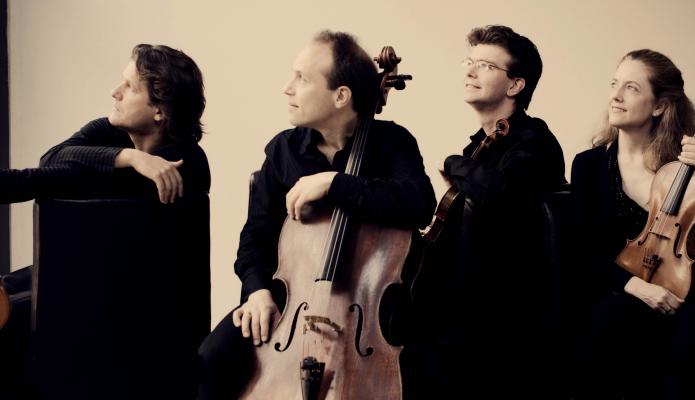St Lawrence String Quartet, LSO String Orchestra, Adams, LSO St Luke's | reviews, news & interviews
St Lawrence String Quartet, LSO String Orchestra, Adams, LSO St Luke's
St Lawrence String Quartet, LSO String Orchestra, Adams, LSO St Luke's
No sitting back and relaxing through a seminal American string symphony and a brain-dizzying quartet

“It looks like the Coconut Lounge,” remarked John Adams as he stepped up jauntily to introduce the first of two big string pieces composed 30 years apart. The folk with their drinks at the candlelit tables, though, were never allowed to sit back and let it all wash over them.
The seminal Shaker Loops of 1978, heard here in its string-orchestra incarnation of five years later, buffets and charges you as it flies or coasts through space, the polar opposite of the more placid minimalism which inspired it. That was nothing, though, compared to the strange adventure of Adams’ recent String Quartet – exhausting for the listener, as it must surely have been for the phenomenal St Lawrence String Quartet, but in a good way.
How thankful we must be that Adams' overhaul of Shaker Loops’ antecedent, Wavemaker, included a double bass among the instruments enriching the original quartet. Add two more for the orchestral version, and in the excellent acoustics of St Luke’s, the LSO trio added a resonance and a rumble that really charged up the engine, bounced into life by a knee-flexing Adams as conductor . In the second of the four seamless movements, "Hymning Slews", those basses made whalesong which complemented what Adams described as the violins’ earlier mewing “like kittens in a box”.
 Here came that much needed smooth background which gave us some respite from the vibrant shakes embodying one half of the title. Adams also had in mind for the third movement an almost extra-terrestrial imitation of what as a child he imagined to be the Shaker sect’s wild ceremonies. Will it ever stop electrifying us with the shock of the new, that series of roof-rocking, steam-train accelerating chords? Audiences in the Seventies and Eighties must have immediately realised they were in the presence of a masterpiece; we still felt it last night.
Here came that much needed smooth background which gave us some respite from the vibrant shakes embodying one half of the title. Adams also had in mind for the third movement an almost extra-terrestrial imitation of what as a child he imagined to be the Shaker sect’s wild ceremonies. Will it ever stop electrifying us with the shock of the new, that series of roof-rocking, steam-train accelerating chords? Audiences in the Seventies and Eighties must have immediately realised they were in the presence of a masterpiece; we still felt it last night.
If they’d been selling a CD and a score on the way out, I’d have bought bothWhere, though, to begin with the Quartet? Any thoughts of similarities with the early work’s shakes at the start were set aside in wonder at the cello’s dazzling pizzicato figures. The St Lawrences (pictured above by Marco Borggreve) tore into it with the total assurance and edge-of-seat commitment that can only come from knowing the work inside out. What can I add to Adams’s own observation of a team who first transfixed him with their playing in John's Book of Alleged Dances that “they can both play as an absolute unity, and also play with four individual personalities that are extraordinary and differentiated”?
That taken for granted, you could only trust them on the journey, which had all the urgency and at times anguish of Janáček's two quartets as well as the unpredictability of Beethoven’s later labyrinths. Fragments of distinctive ideas that rarely surface anywhere in many new works were hurled around the four players before you had time to grasp them, though with a crucial slowing of the pulse the scalic patterns shared in haunting dialogue did have space to make their mark. Full energy regained at the end, the St Lawrence players sent me stumbling out with brainache – again, in a good way. If they’d been selling a CD and a score on the way out, I’d have bought both and absorbed myself into the small hours. But then you’d have had to wait a lot longer for what as it stands has to be a mere superficial eulogy in praise of - yes, another masterpiece.
rating
Explore topics
Share this article
The future of Arts Journalism
You can stop theartsdesk.com closing!
We urgently need financing to survive. Our fundraising drive has thus far raised £49,000 but we need to reach £100,000 or we will be forced to close. Please contribute here: https://gofund.me/c3f6033d
And if you can forward this information to anyone who might assist, we’d be grateful.

Subscribe to theartsdesk.com
Thank you for continuing to read our work on theartsdesk.com. For unlimited access to every article in its entirety, including our archive of more than 15,000 pieces, we're asking for £5 per month or £40 per year. We feel it's a very good deal, and hope you do too.
To take a subscription now simply click here.
And if you're looking for that extra gift for a friend or family member, why not treat them to a theartsdesk.com gift subscription?
more Classical music
 Lammermuir Festival 2025, Part 2 review - from the soaringly sublime to the zoologically ridiculous
Bigger than ever, and the quality remains astonishingly high
Lammermuir Festival 2025, Part 2 review - from the soaringly sublime to the zoologically ridiculous
Bigger than ever, and the quality remains astonishingly high
 BBC Proms: Ehnes, Sinfonia of London, Wilson review - aspects of love
Sensuous Ravel, and bittersweet Bernstein, on an amorous evening
BBC Proms: Ehnes, Sinfonia of London, Wilson review - aspects of love
Sensuous Ravel, and bittersweet Bernstein, on an amorous evening
 Presteigne Festival 2025 review - new music is centre stage in the Welsh Marches
Music by 30 living composers, with Eleanor Alberga topping the bill
Presteigne Festival 2025 review - new music is centre stage in the Welsh Marches
Music by 30 living composers, with Eleanor Alberga topping the bill
 Lammermuir Festival 2025 review - music with soul from the heart of East Lothian
Baroque splendour, and chamber-ensemble drama, amid history-haunted lands
Lammermuir Festival 2025 review - music with soul from the heart of East Lothian
Baroque splendour, and chamber-ensemble drama, amid history-haunted lands
 BBC Proms: Steinbacher, RPO, Petrenko / Sternath, BBCSO, Oramo review - double-bill mixed bag
Young pianist shines in Grieg but Bliss’s portentous cantata disappoints
BBC Proms: Steinbacher, RPO, Petrenko / Sternath, BBCSO, Oramo review - double-bill mixed bag
Young pianist shines in Grieg but Bliss’s portentous cantata disappoints
 theartsdesk at the Lahti Sibelius Festival - early epics by the Finnish master in context
Finnish heroes meet their Austro-German counterparts in breathtaking interpretations
theartsdesk at the Lahti Sibelius Festival - early epics by the Finnish master in context
Finnish heroes meet their Austro-German counterparts in breathtaking interpretations
 Classical CDs: Sleigh rides, pancakes and cigars
Two big boxes, plus new music for brass and a pair of clarinet concertos
Classical CDs: Sleigh rides, pancakes and cigars
Two big boxes, plus new music for brass and a pair of clarinet concertos
 Waley-Cohen, Manchester Camerata, Pether, Whitworth Art Gallery, Manchester review - premiere of no ordinary violin concerto
Images of maternal care inspired by Hepworth and played in a gallery setting
Waley-Cohen, Manchester Camerata, Pether, Whitworth Art Gallery, Manchester review - premiere of no ordinary violin concerto
Images of maternal care inspired by Hepworth and played in a gallery setting
 BBC Proms: Barruk, Norwegian Chamber Orchestra, Kuusisto review - vague incantations, precise laments
First-half mix of Sámi songs and string things falters, but Shostakovich scours the soul
BBC Proms: Barruk, Norwegian Chamber Orchestra, Kuusisto review - vague incantations, precise laments
First-half mix of Sámi songs and string things falters, but Shostakovich scours the soul
 BBC Proms: Alexander’s Feast, Irish Baroque Orchestra, Whelan review - rapturous Handel fills the space
Pure joy, with a touch of introspection, from a great ensemble and three superb soloists
BBC Proms: Alexander’s Feast, Irish Baroque Orchestra, Whelan review - rapturous Handel fills the space
Pure joy, with a touch of introspection, from a great ensemble and three superb soloists
 BBC Proms: Moore, LSO, Bancroft review - the freshness of morning wind and brass
English concert band music...and an outlier
BBC Proms: Moore, LSO, Bancroft review - the freshness of morning wind and brass
English concert band music...and an outlier
 Willis-Sørensen, Ukrainian Freedom Orchestra, Wilson, Cadogan Hall review - romantic resilience
Passion, and polish, from Kyiv's musical warriors
Willis-Sørensen, Ukrainian Freedom Orchestra, Wilson, Cadogan Hall review - romantic resilience
Passion, and polish, from Kyiv's musical warriors

Add comment